AI at Work
AI-Powered Ad Creation for Retail Campaigns: A Step-by-Step Guide

Neelam Goswami · Content Marketing Associate
May 26th, 2025 · 15 min read
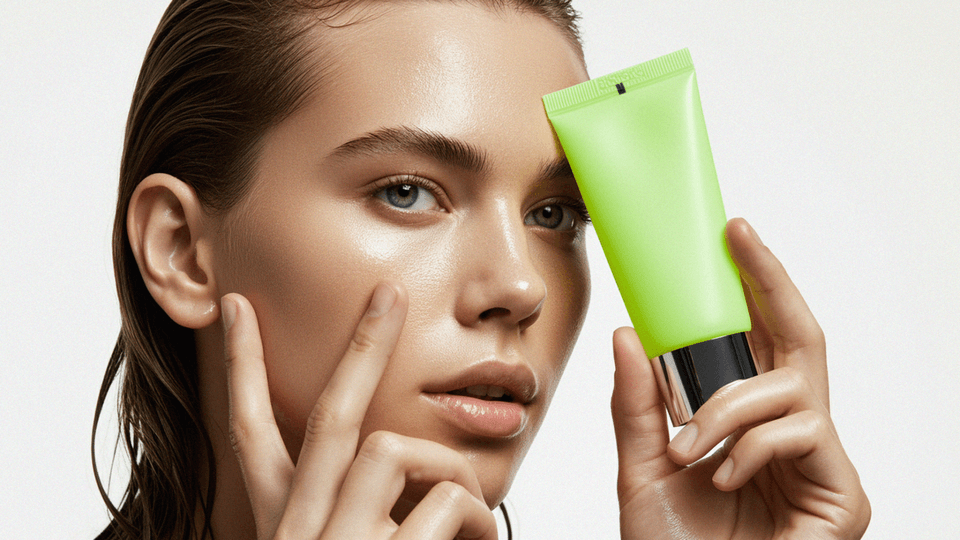
You and your team are juggling a ton—top‑of‑funnel awareness, mid‑funnel engagement, all while trying to stand out in an overcrowded retail space. And it’s only getting louder: According to eMarketer, the retail media ad spending is projected to reach $97.91 billion by 2028. That’s a clear sign that brands are heavily investing in visibility.
But, to do it right, you need a combination of speed, quality, and scale. We've seen marketing teams struggle with this challenge, especially when seasonal campaigns, promotions, and product launches all require fresh creatives simultaneously. That's where AI ad generators can actually help — without derailing your brand voice. Generative AI tools can automate much of the heavy lifting involved in creative development.
From generating personalized ad copy to AI-powered creatives and product photography, generative AI in retail marketing can help you significantly scale content production while adhering to your brand's standards.
Why are retail marketers struggling with ad creation at scale?
What specific pain points do generative AI advertising tools address?
What types of retail ads can AI tools create?
How to use an AI ad generator for retail campaigns
Measuring success of AI-generated retail ads
Frequently asked questions about AI ad generators
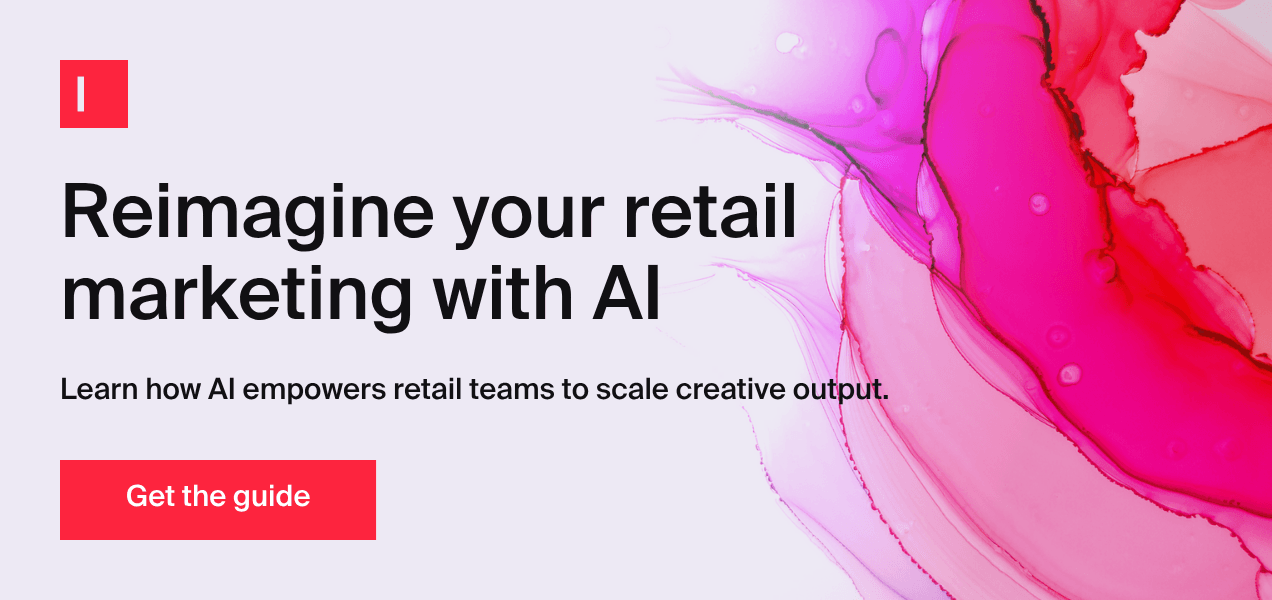
Why are retail marketers struggling with ad creation at scale?
The traditional ad creation process wasn't designed for today's multi-channel, personalized marketing requirements. The average retail marketer needs to produce hundreds of ad variations every month. Each product category, seasonal promotion, and targeted audience segment requires unique creative assets across multiple channels and formats. This often leads to chaos as:
Creative bottlenecks delay campaign launches when designers can't keep pace with requests
Brand inconsistency emerges when rushed work bypasses proper review processes
Channel optimization suffers when teams lack resources to create format-specific variations
Testing becomes limited when producing multiple creative variants is too time-intensive
This constant struggle to produce more with less pushes many retail marketing teams close to their breaking point.
What specific pain points do generative AI advertising tools address?
The biggest problems that AI ad tools help solve are tied to scale, formatting (channel specific requirements), speed of production, and costs. Here’s a breakdown:
Scale without sacrifice: Producing dozens of variations while maintaining quality and branding standards.
Format flexibility: Converting core creative concepts across multiple channel dimensions and specs
Rapid adaptation: Updating seasonal messaging across entire product catalogs quickly
Personalization at scale: Creating audience-specific creatives without multiplying workload
Cost efficiency: Reducing production costs for high-volume advertising needs
What types of retail ads can AI tools create?
AI ad generation tools are versatile. Now, with AI agents now adding to this versatility and flexibility, you can create almost any type of retail ad with AI, including:
Display ads: AI display ads can include banner ads for different sizes and placements, such as in-store, POS, or native advertising.
Social media ads: AI social ad generators tailor content to each platform’s format, whether that’s Instagram posts, Facebook carousel ads, or TikTok videos.
Video ads: An AI video ad creator can generate short-form videos based on brand assets and messaging guidelines.
Text ads: AI copywriters can write catchy headlines, taglines, and descriptions that resonate with your target audience.
How to use an AI ad generator for retail campaigns
A fail-proof marketing strategy is one that combines human expertise with generative AI's efficiency. To build an AI-powered ad campaign that delivers results, retail marketers must first have a complete understanding of their brand and audience. This not only gives you campaigns direction, but also helps AI deliver more on-brand, personalized outputs.
Here’s a step-by-step guide on how to set up your AI advertising strategy for success.
Step 1: Prepare your brand assets
Typeface's AI ad generator offers some powerful brand management capabilities that allow you to generate content that truly reflects your brand voice and personality.
So, before you begin using AI for ad production, you should prepare and organize your key brand assets on Brand Hub. Some crucial brand elements that you can consider adding to the Brand Hub are:
Visual identity components: Logos, color palettes, image styles, and fonts
Product imagery: High-quality, consistent product photography with clean backgrounds
Text style guidelines: Tone, terminology preferences, and messaging principles
Brand rules: Brand voices and style settings like preferences around the use of punctuations, emojis, contractions, first person and so on
Brand assets: Documentation and assets that the AI can learn from
You can add your brand assets and guidelines manually or import them from existing brand guides using a file or a URL. Our Brand Agent can turn these guidelines into comprehensive Brand Kits to be applied when generating content with AI.
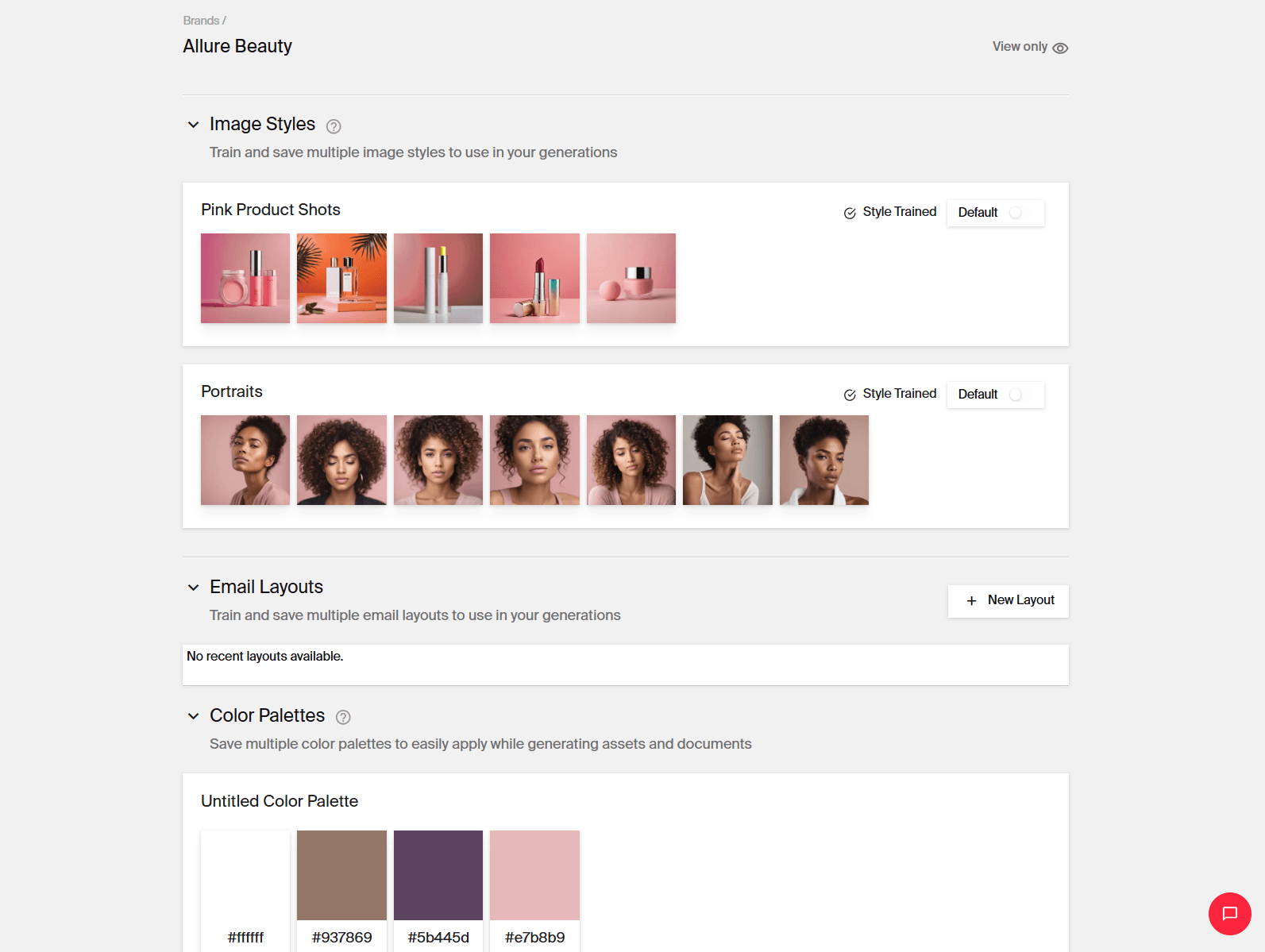
Brand Hub on Typeface
When you create a structured, unified source of truth for your brand, you make sure that every piece of AI-generated content (text and visual) maintains brand consistency.
Step 2: Set up audiences
Another key aspect of any marketing campaign is the target audience. Typeface enables dynamic personalization of your campaigns for different audience segments. For this, you need to save your audience personas on the platform. Typically, this would include:
Demography: Gender, age, and location
Preferences: Hobbies, profession, lifestyle, or other interests
Spending behavior: Budget conscious, aspirational, value-oriented, or other attributes that define what they look for when making purchase decisions
Existing audience segments can be easily imported from your customer data platforms (CDPs) or manually added on Typeface.
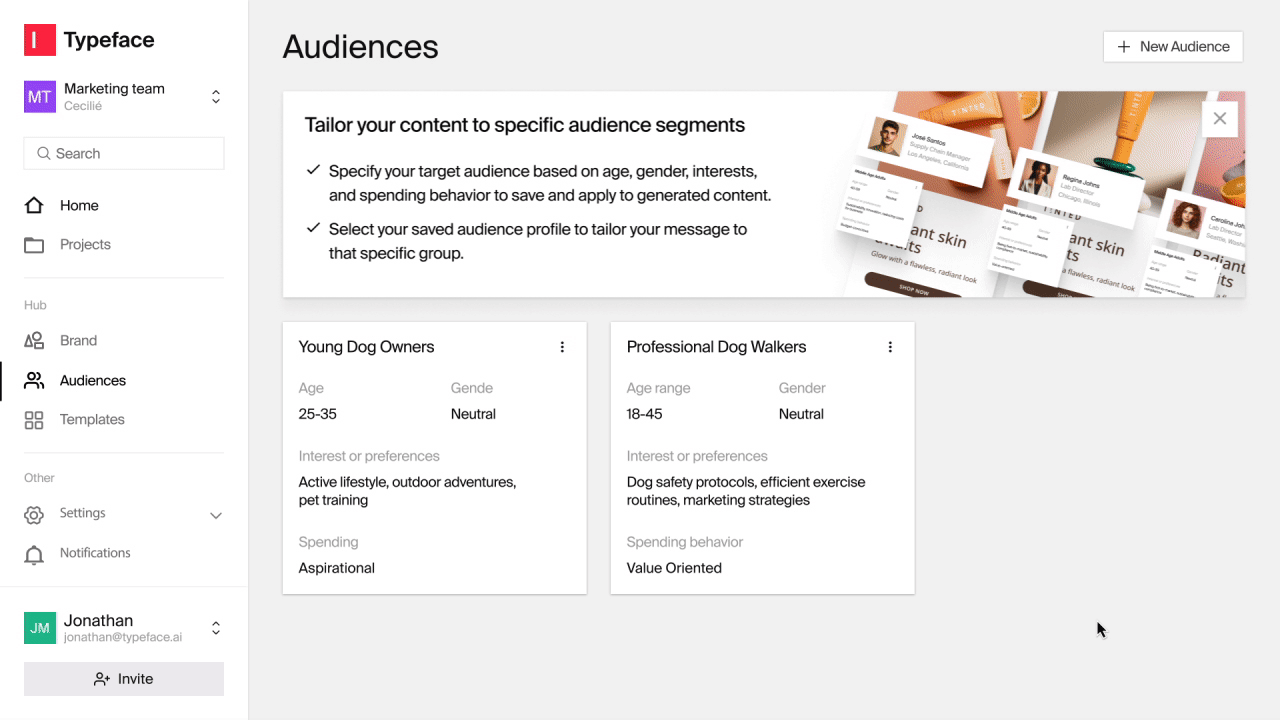
Step 3: Define campaign goals
To create ad campaigns that are relevant, timely, and effective, you’ve got to set clear goals for your campaign. Are you aiming to increase brand awareness, drive conversions, or promote a specific product line? Well-defined objectives will give AI tools more context to generate the type of content that will resonate most with your audience.
Step 4: Import existing design templates
If you have existing design templates that you’d like to use for future ad campaigns too, Typeface lets you seamlessly import your Photoshop and Figma files. This way you can save brand elements and aspect ratios for repeated use in future campaigns.
Step 5: Use AI agents to create multiple campaign variations
Once your Brand Hub, audiences, designs, and campaign goals are set, our AI is ready to start creating your retail ad campaigns. Typeface creative agents offer an intuitive and flexible way to create full-funnel, multi-channel campaigns using your approved creatives and templates.
Typeface Arc Agents work like your AI team members that understand context, interact with other agents, and can even suggest the next best actions.
Create a single channel ad
To kickstart your campaign, you can type in your request on Typeface Chat. For instance, "Create a Facebook ad campaign to promote of Spring-Summer Collection for Women".
AI agents are great at understanding natural language, which means that you don't need any elaborate prompts to generate the desired output. If your request is clear enough, the Ad Agent will step in to start generating the campaign.
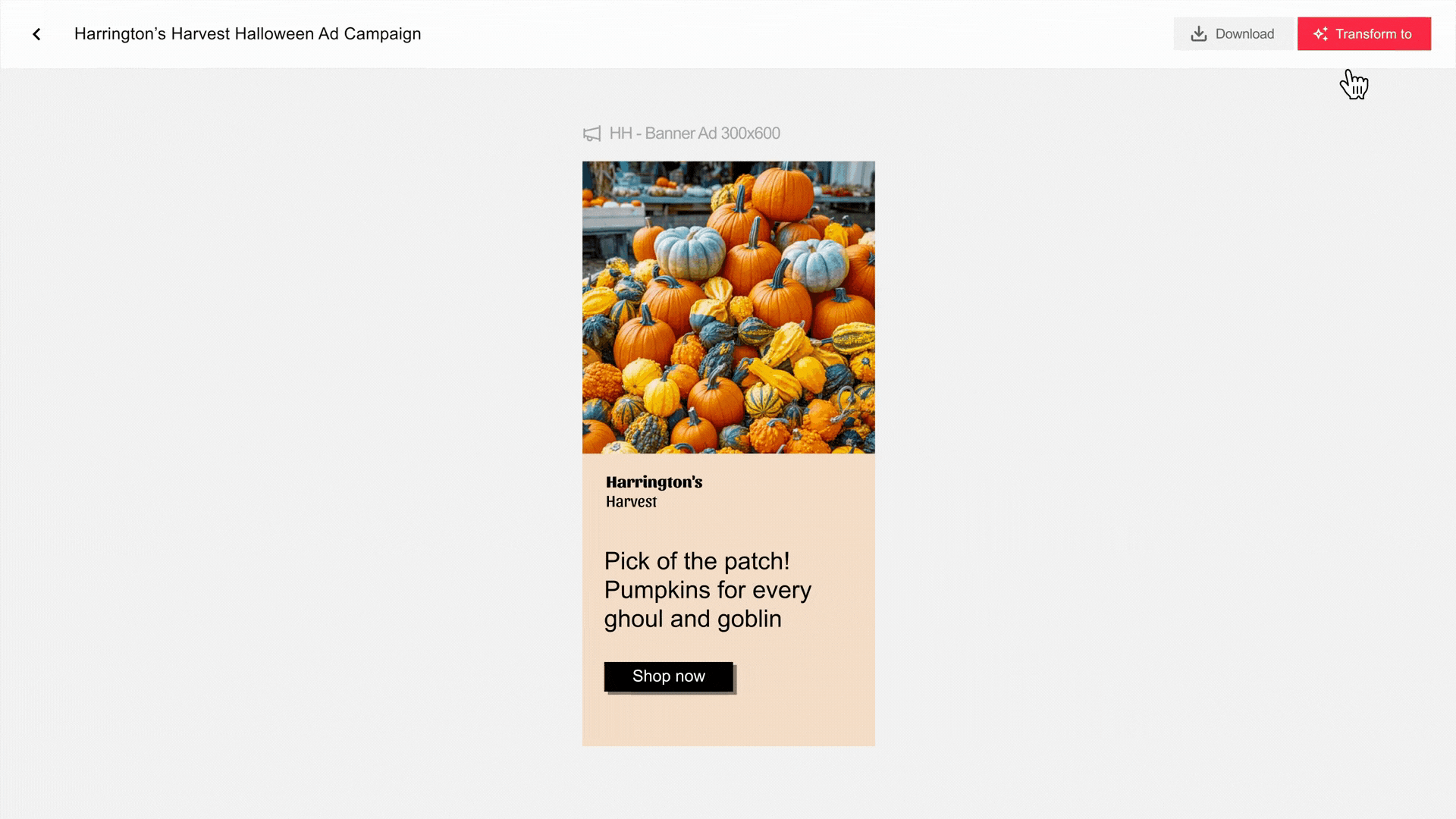
Ad Agent on Typeface
If the agent needs more context, it may ask you follow-up questions like "What is your campaign/ad goal", "Do you want to use existing assets or create new ones", or "What products are you offering".
Our AI agents can handle some ambiguity; but it is best to provide a detailed brief to the agent so you can arrive at the best output faster. Your request should ideally contain:
Campaign goal
Audience
Channel
Brand Kit
Product details
Ad type/layout/template
Pre-approved assets, if any
If you happen to miss some instructions or want to make changes to your inputs, you can always course correct, and the AI agents will be able to pivot to the new reasoning.
In case you do not have any existing product shots or creatives to use for your ad campaign, our AI agent helps generate fresh assets with Visual Inspiration Studio.
The Ad Agent can autonomously interact with Brand Agent to incorporate your brand guidelines and audiences into the content.
Here’s a real-world scenario where Ad Agent helps
Here’s a real-world scenario where Ad Agent helps
A clothing retailer preparing for Black Friday Sale can instantly generate hundreds of product-specific ads featuring different items, color variations, and promotional messaging, rather than manually designing each creative.
For some interesting tips on AI product photography, check out our guide on how to maintain brand consistency with AI image generators.
Create multi-channel ad campaigns
Typeface Ad Agent can also help you build multi-channel retail ad campaigns at once. For instance, you can ask the AI agent to create an ad campaign for paid social and Google Ads based on an existing Figma design.
Creative automation capabilities on Typeface can generate multiple versions of the ad campaign tailored for different channels, while ensuring that the integrity of your original design is maintained.
Another example could be asking the AI agent to turn a banner ad you created into social media ads:
Given that the layout of an Instagram ad or a Facebook ad would be different from a POS banner ad, manually resizing this would be a lot of additional effort.
Our AI agent can automatically reformat your ad creatives to any aspect-ratio or channel-specific layout using its image out-painting and smart cropping capabilities.
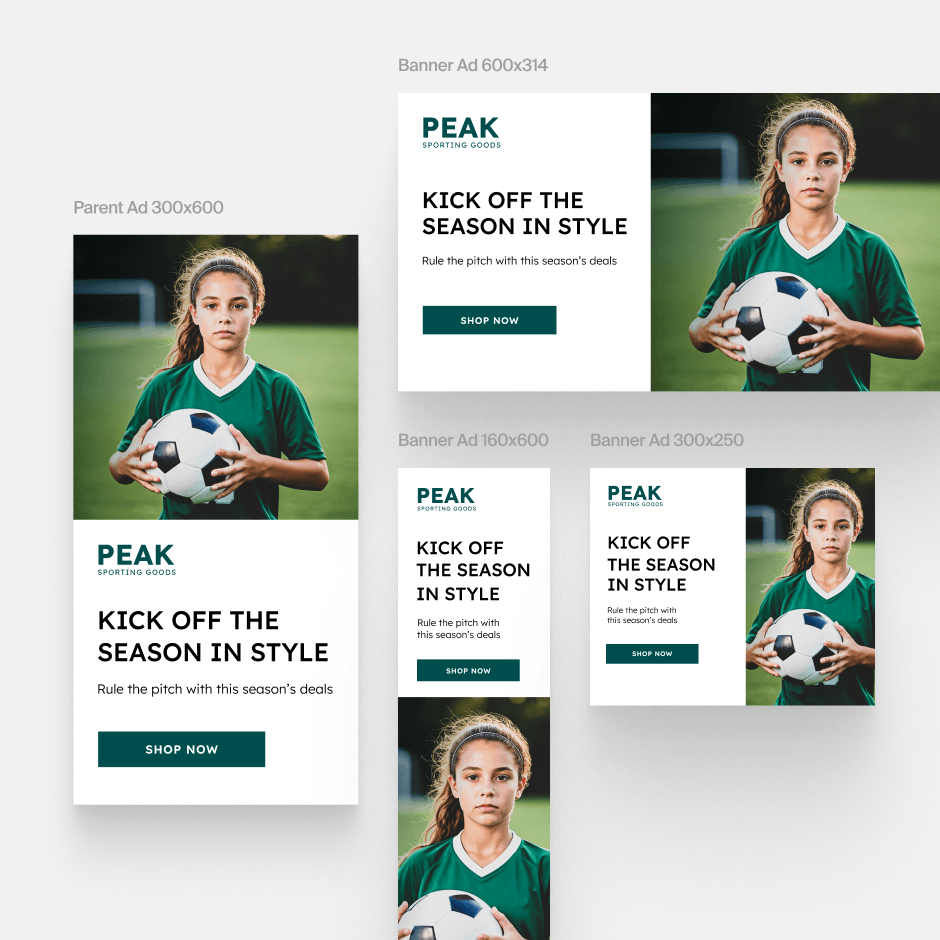
Resizing an approved ad creative for multiple channels with Typeface
Create audience personalized versions of your ad campaign
Retail businesses usually cater to a wide range of consumers, which means that your ad campaigns also need to connect with different audience segments. Scaling your campaigns across different audiences while maintaining a consistent brand identity and quality standards can be a daunting task for marketers.
Typeface makes this simpler with its ability to generate personalized variations of your ad for different segments, within your approved design templates. The Ad Agent can personalize both messaging and imagery to resonate with each target audience.
What does AI-driven personalization in retail advertising look like?
What does AI-driven personalization in retail advertising look like?
A beauty brand can generate dozens of creative variations for the same product, testing different models, backgrounds, copy styles, and calls-to-action simultaneously to test what works best for different audience segments and optimize performance faster than traditional methods.
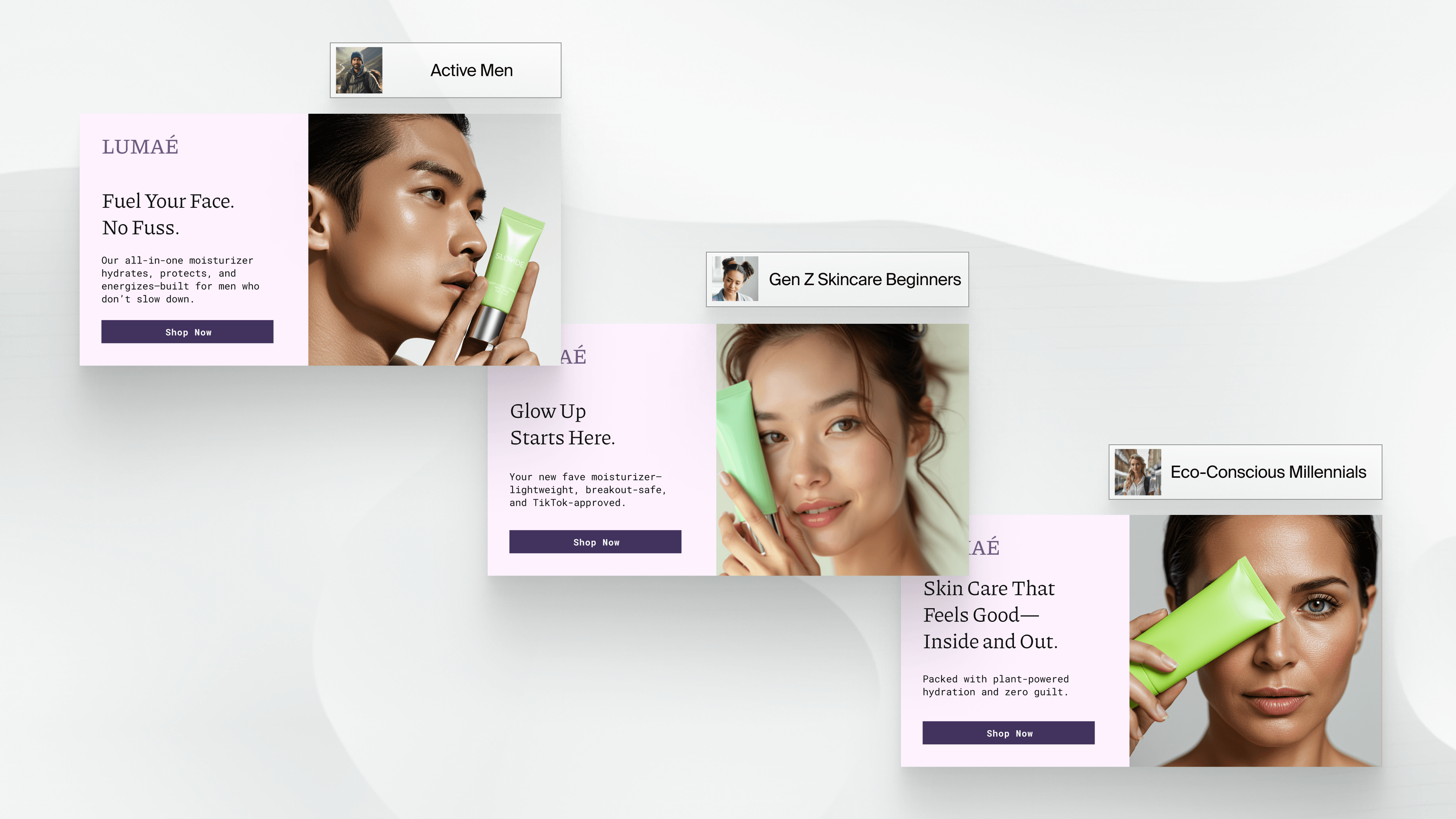
Audience-personalized variations of an ad campaign generated on Typeface
Localize ad campaigns for different markets
If your retail business spans across different markets globally, ensuring your ads are relevant to each market is crucial. Localizing your ad campaigns goes beyond just translating the copy. The overall look and feel of your ad should also strike the right chord with local consumers.
Typeface allows you to automatically adapt approved ad designs, including images, headlines and brand elements, into localized versions without any redesign involved. You can generate multiple localized variations with different tones, colors and messaging to test campaign performance and optimize campaigns on the fly.
Here’s how retailers can leverage AI-powered localization
Here’s how retailers can leverage AI-powered localization
A furniture retailer expanding internationally can generate localized campaigns that maintain brand identity while adapting to cultural preferences. For example, their Scandinavian-style dining set gets promoted with cozy family gatherings in the US market, minimalist aesthetic focus in Japan, and entertaining-focused messaging in Brazil — all while keeping consistent product photography and core brand colors across Google Ads, Instagram, and local platforms.
The AI doesn't just resize images; it understands that a "modern living room" means different things in a Tokyo apartment versus a Texas suburban home, ensuring the same product looks native to each market's aspirations.
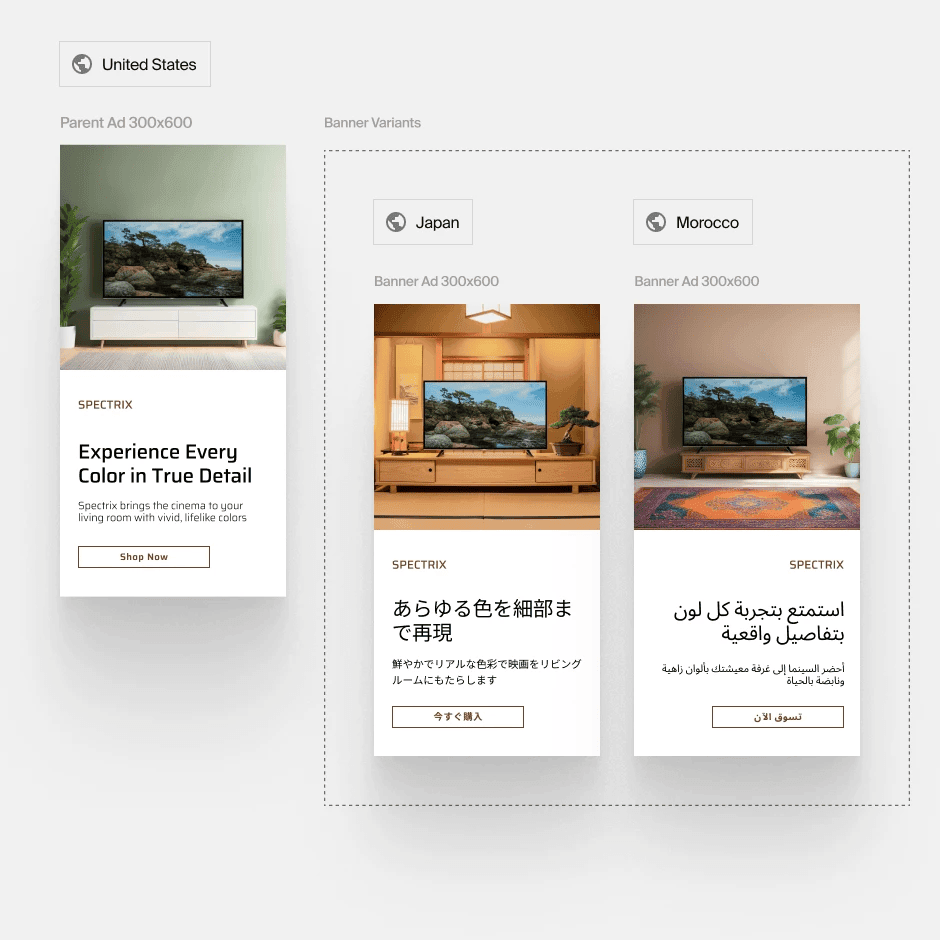
Localized versions of an ad campaign generated on Typeface
Step 6: Publish your ads directly from Typeface
Typeface connects with your ad platforms and social media platforms, including Google Ads, Meta Ads, Facebook and LinkedIn. This lets you export your campaigns to designated platforms directly from Typeface with the right layout, preview ads, and publish.
Our integration with Google Ads also lets marketers easily create Performance Max assets at scale. You can generate multiple images, headlines, and descriptions through Typeface and instantly publish them to campaigns in a few clicks.
Most retail businesses advertising with Google are seeing great results with Performance Max campaigns. Typeface empowers retailers with seamless workflows here, driving speed and scale, so you can spend less time on content creation and more on campaign optimization, ensuring better results.
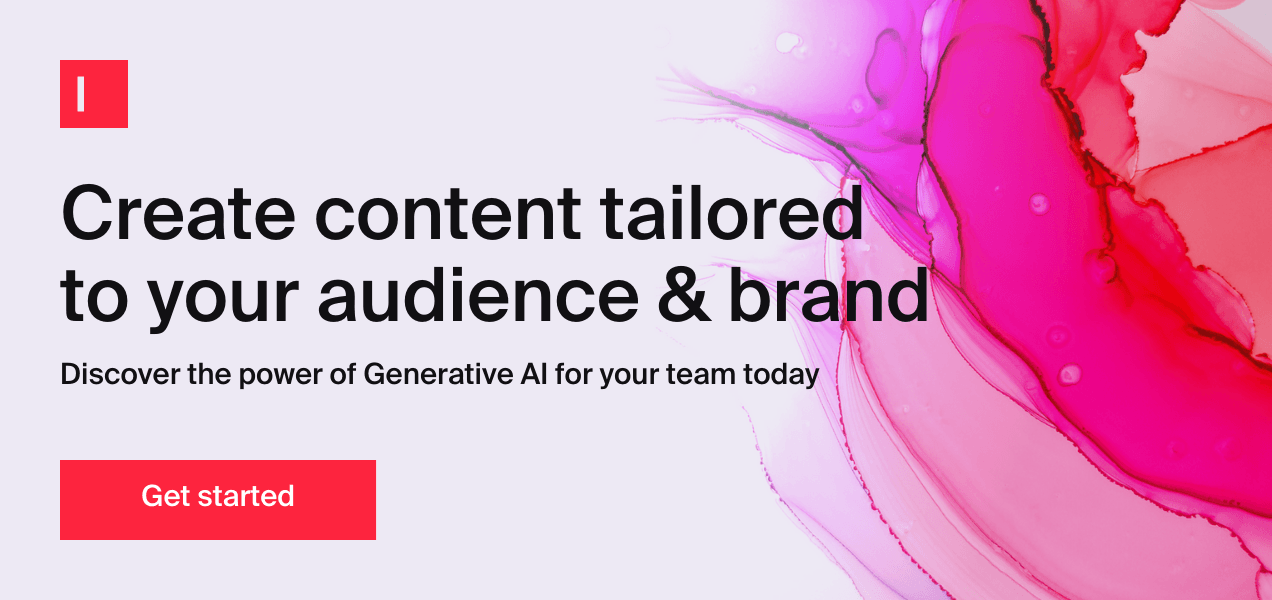
Measuring success of AI-generated retail ads
Which metrics best evaluate AI ad performance versus traditional methods?
The true value of AI ad generation comes from both production efficiency and marketing effectiveness. Track both aspects to demonstrate comprehensive ROI.
Production efficiency metrics you can evaluate:
Time-to-market reduction (hours saved per campaign)
Volume capacity increase (number of variants produced vs traditional process)
Resource allocation shifts (designer/copywriter time on strategic vs. production tasks)
Cost-per-ad reduction (total production cost divided by ad volume)
Marketing performance metrics:
Click-through rate comparison (AI vs. traditional)
Conversion rate by ad type
Creative testing velocity (number of variants tested per campaign)
Performance consistency across product categories
How can A/B testing inform your AI ad optimization strategy?
AI-powered ad creation enables more sophisticated testing approaches:
Element-level testing: Isolate specific components (headlines, backgrounds, CTAs) to identify what drives performance
Template comparison testing: Compare fundamentally different creative approaches for the same products
Audience-specific optimization: Test which creative variations resonate with different customer segments
Channel-specific refinement: Compare performance patterns across different advertising platforms
Seasonal effectiveness analysis: Measure how template performance varies during different retail seasons
AI ad testing can be more comprehensive simply because of the phenomenal speed of AI generation compared to traditional methods. Instead of testing 2-3 concepts, retail marketers using AI ad generators can test dozens of variations and combinations, leading to more refined performance insights.
Frequently asked questions about AI ad generators
How much human oversight is still needed with AI ad generators for retail campaigns?
While an AI ad generator dramatically reduces production time, human oversight remains essential for strategic direction, initial template creation, and quality control reviews. Most successful implementations use human approval for new templates and spot-check ongoing production. Typeface makes this easier with its content workflow management and collaboration features that allow your team to manage production and reviews on a single platform.
Can AI-powered ad creation maintain consistent brand voice across different ad formats?
Yes! (With proper setup.) The key is creating comprehensive brand guidelines that the AI system can interpret. This means developing clear rules for visual elements, messaging tone, and terminology use. Most retail marketers find that consistency actually improves across ad formats with AI compared to having multiple designers working independently, as AI systems apply rules uniformly across all outputs.
What level of technical expertise does my marketing team need to implement AI ad generation?
Marketing teams don’t need any technical expertise to use an AI ad generator. Typeface AI agents practically work like an AI team member that understands tasks and converses in natural language. The AI agents can also interact with other agents and connected apps in your ecosystem to make autonomous decisions for content creation, minimizing the amount of human effort needed.
The learning curve typically focuses on rule setting rather than technical programming. Most retail marketing teams can implement basic AI ad generation with just 1-2 days of platform training.
How do AI ad generators handle seasonal retail promotions and time-sensitive campaigns?
Our AI ad generator is great at applying seasonal themes and promotional messaging across product catalogs. With Visual Inspiration Studio and Ad Agent, marketers can create seasonal campaigns, like Back-to-School or Holiday promotions, in minutes rather than days of manual design work.
What security measures protect our brand assets when using AI ad generation tools?
Our enterprise-grade AI marketing platform implements multiple security layers, including role-based access controls and secure cloud storage with end-to-end encryption.
Responsible AI and security and governance settings also help make sure that all the content generated maintain brand and legal compliance.
Raise the bar in retail advertising with AI-powered campaigns
AI ad generators are transforming retail marketing by solving the fundamental challenge of scaling creative production without sacrificing quality or brand consistency. By following a methodical approach — from initial template development to performance measurement — retail marketers can successfully integrate these tools into their existing workflow.
The most successful implementations maintain a balance between human creativity and AI efficiency, allowing more time for strategic thinking and creative innovation.
Try creating your first retail ad campaign with Typeface! Book a demo with us to understand more about the features and capabilities.
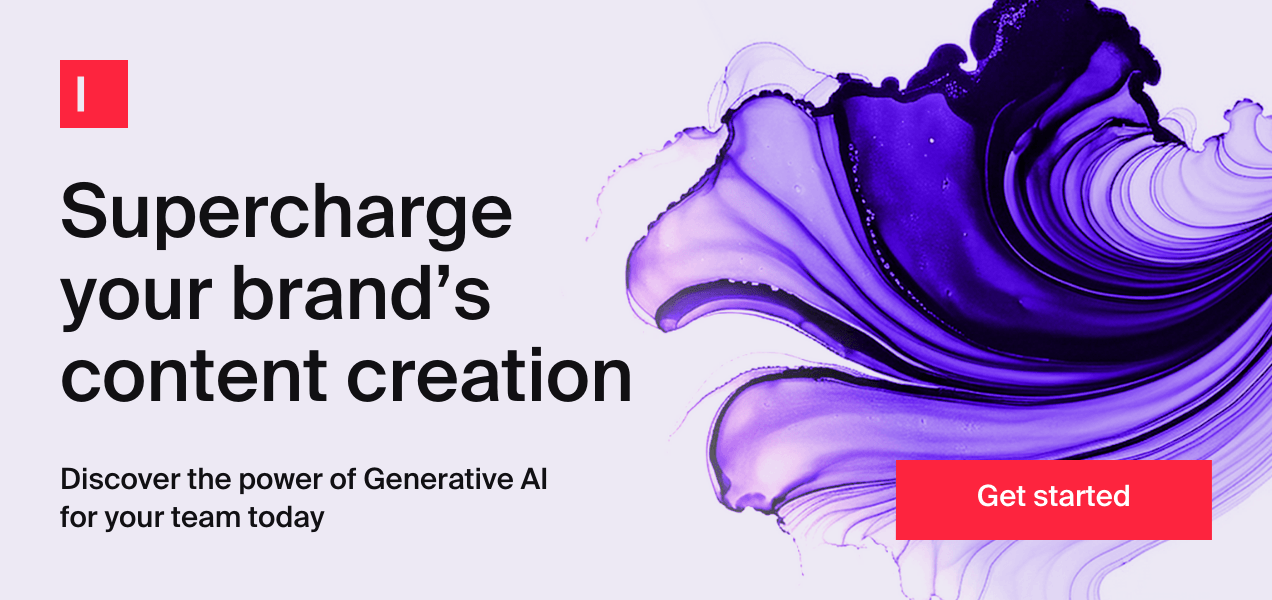
Share
Related articles

AI at Work
5 Google Ad Examples & How to Use AI Ad Generator to Create Them

Akshita Sharma · Content Marketing Associate
April 1st, 2025 · 15 min read
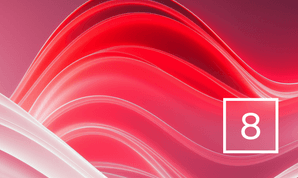
AI at Work
8 Ways to Improve the eCommerce Customer Journey with AI Content Creation

Neelam Goswami · Content Marketing Associate
April 25th, 2025 · 15 min read

AI at Work
Content Personalization Best Practices to Personalize Copy for Specific Audiences

Neelam Goswami · Content Marketing Associate
February 12th, 2025 · 15 min read